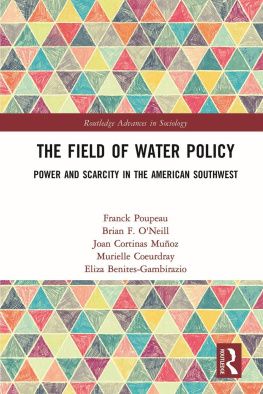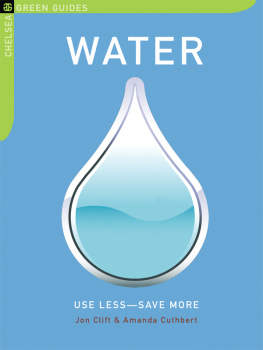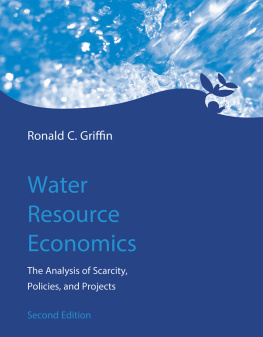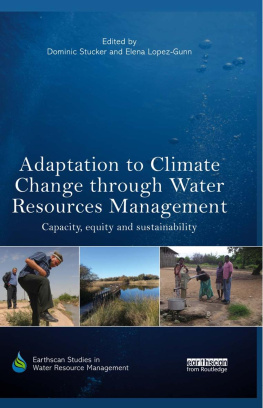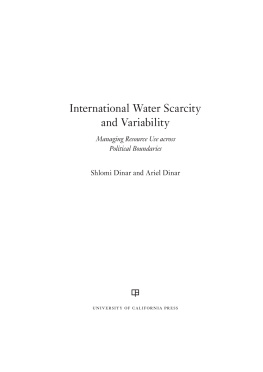Climate Variability and Water Dependent Sectors
Demand for water in agricultural, municipal, industrial, and environmental uses is growing. More frequent and severe extreme weather conditions now exacerbate water shortages in many locations and existing infrastructure to store and release water rarely has the capacity to both prevent floods during wet periods and meet demand during drought periods. Competition among sectors adds pressure not only on water infrastructure, but also on management policies and allocation institutions.
This book of contributed chapters assesses the performance of existing infrastructure, institutions and policies under different climate variability scenarios. It also provides suggestions for minimizing conflict over scarce water resources. More flexible water-allocation institutions and management policies, and better tools for decision-making under uncertainty will be required to maximize societys net benefit from less reliable water resources. The chapters show how incentives for individuals to conserve water, and policies for helping vulnerable populations prepare for and recover from extreme events, will also need to be improved.
This book was originally published as a special issue of the Journal of Natural Resources Policy Research.
Dannele E. Peck is an associate professor in the Department of Agricultural and Applied Economics at the University of Wyoming, USA.
Jeffrey M. Peterson is a professor in the Department of Agricultural Economics at Kansas State University, USA.
Climate Variability and Water Dependent Sectors
Impacts and Potential Adaptations
Edited by
Dannele E. Peck and Jeffrey M. Peterson
First published 2015
by Routledge
2 Park Square, Milton Park, Abingdon, Oxon, OX14 4RN, UK
and by Routledge
711 Third Avenue, New York, NY 10017, USA
Routledge is an imprint of the Taylor & Francis Group, an informa business
2015 Taylor & Francis
All rights reserved. No part of this book may be reprinted or reproduced or utilised in any form or by any electronic, mechanical, or other means, now known or hereafter invented, including photocopying and recording, or in any information storage or retrieval system, without permission in writing from the publishers.
Trademark notice: Product or corporate names may be trademarks or registered trademarks, and are used only for identification and explanation without intent to infringe.
British Library Cataloguing in Publication Data
A catalogue record for this book is available from the British Library
ISBN 13: 978-1-138-80733-4
ePub eISBN 13: 978-1-317-61426-5
Mobipocket/Kindle eISBN 13: 978-1-317-61425-8
Typeset in Times New Roman
by RefineCatch Limited, Bungay, Suffolk
Publishers Note
The publisher accepts responsibility for any inconsistencies that may have arisen during the conversion of this book from journal articles to book chapters, namely the possible inclusion of journal terminology.
Disclaimer
Every effort has been made to contact copyright holders for their permission to reprint material in this book. The publishers would be grateful to hear from any copyright holder who is not here acknowledged and will undertake to rectify any errors or omissions in future editions of this book.
Contents
Dannele E. Peck and Jeffrey M. Peterson
Aaron Benson and Ryan Williams
Russell J. Qualls, R. Garth Taylor, Joel Hamilton and Ayodeji B. Arogundade
George B. Frisvold and Shailaja Deva
Bill Golden and Jeff Johnson
Amy Sherwood
Bhagyam Chandrasekharan and Bonnie Colby
Karina Schoengold, Prabhakar Shrestha and Mark Eiswerth
The chapters in this book were originally published in the Journal of Natural Resources Policy Research, volume 5, issue 23 (AprilJuly 2013). When citing this material, please use the original page numbering for each article, as follows:
Chapter 1
Introduction to the special issue on Climate Variability and Water-Dependent Sectors: Impacts and Potential Adaptations
Dannele E. Peck and Jeffrey M. Peterson
Journal of Natural Resources Policy Research, volume 5, issue 23 (AprilJuly 2013) pp. 7378
Chapter 2
Cost of early snowmelt in terms of reduced irrigation deliveries
Aaron Benson and Ryan Williams
Journal of Natural Resources Policy Research, volume 5, issue 23 (AprilJuly 2013) pp. 7990
Chapter 3
Climate change opportunities for Idahos irrigation supply and deliveries
Russell J. Qualls, R. Garth Taylor, Joel Hamilton and Ayodeji B. Arogundade
Journal of Natural Resources Policy Research, volume 5, issue 23 (AprilJuly 2013) pp. 91106
Chapter 4
Climate and choice of irrigation technology: implications for climate adaptation
George B. Frisvold and Shailaja Deva
Journal of Natural Resources Policy Research, volume 5, issue 23 (AprilJuly 2013) pp. 107128
Chapter 5
Potential economic impacts of water-use changes in Southwest Kansas
Bill Golden and Jeff Johnson
Journal of Natural Resources Policy Research, volume 5, issue 23 (AprilJuly 2013) pp. 129146
Chapter 6
Community adaptation to climate change: exploring drought and poverty traps in Gituamba location, Kenya
Amy Sherwood
Journal of Natural Resources Policy Research, volume 5, issue 23 (AprilJuly 2013) pp. 147162
Chapter 7
Medium-term electricity load forecasting and climate change in arid cities
Bhagyam Chandrasekharan and Bonnie Colby
Journal of Natural Resources Policy Research, volume 5, issue 23 (AprilJuly 2013) pp. 163182
Chapter 8
The joint impact of drought conditions and media coverage on the Colorado rafting industry
Karina Schoengold, Prabhakar Shrestha and Mark Eiswerth
Journal of Natural Resources Policy Research, volume 5, issue 23 (AprilJuly 2013) pp. 183198
Please direct any queries you may have about the citations to clsuk.permissions@cengage.com
Dannele E. Pecka and Jeffrey M. Petersonb
aDepartment of Agricultural & Applied Economics, University of Wyoming; bDepartment of Agricultural Economics, Kansas State University
Water stress is an increasingly important challenge for the twenty-first century. Demand for water resources in agricultural, municipal, industrial, and environmental uses is rising due to population and income growth. Climate change is expected to exacerbate water stress by increasing the frequency and severity of extreme weather conditions. Although drought may not become more frequent or severe in all locations, growing demand for water will cause scarcity to become more pressing over larger geographic areas. In many locations, infrastructure to store and release water currently lacks the capacity to meet demand during drought periods and prevent floods during wet periods. Competition for scarce water resources, both within and among sectors, will place even greater pressure on existing infrastructure, as well as current water allocation institutions and management policies.


